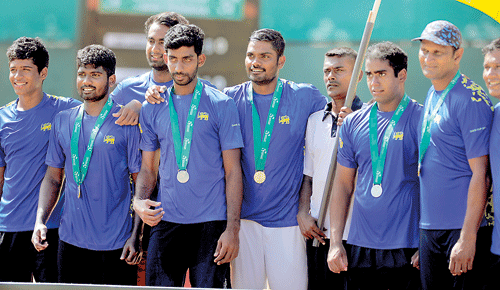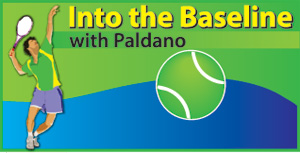Tennis transition from national to regional
View(s):
The victorious SL Davis Cup team
Tennis standards are National, Regional and Global. Countries in Groups II and III Davis-Cup and Fed Cup are caught up beneath the Regional Tennis standard, and unable to get out of it. It is a global syndrome. Some of the countries in these Groups have thriving economies. One such nation that appeared in Colombo for the Group III competition had their team trained in Paris for over a month, to ensure they do not get relegated. This reflects desperateness, rather than a planned programme.
Unfortunately, transition of playing standards upwards does not happen by short term, intensified infusions. A nation has to exhibit a strong sporting culture to see transition upwards. Quick fixes never work.
What is needed
Maturity, sports intelligence, skill, exposure and physical ability of players are links to high performance Sport. Home-playing standard is the platform which decides the player development of a nation, and not intensified coaching. In fact intensified coaching takes the fun away from sport and burns the child motivation. Tennis registers the highest dropout for this reason. Parents often discover this after wasting much money and irreplaceable childhood of their brood.
If home Tennis standard is low in a country, there is no way a player evolving from such a condition will be a world beater. To enhance home-playing standards, direction, design and responsibility of the sports administration holds the key.
Unable to sustain good standard in Tennis and in other sports, leads to a mixed bag of performances from our players. For example, it is true we won a promotional slot to go up to Group II of Davis Cup next year, well done. It is also true we came down last year from Group II. Often, in countries like ours, the situation that exists is far from the well designed blueprint or, effective modification to the changing local situations. The truth is that, transition to global standard from regional and national standard is only possible with sustainable design and administrative responsibility.
Where were we in Tennis?
A good few decades ago, Asia was not fully woken up to the game of Tennis. The potential of Asia was always very big, and our own standard was on par with many leading countries in the world. Arguably, we were Ranked 3 in Asia with the Philippines. India was 1st and Japan 2nd. These are the countries that could beat us. Till about the early ’90s, Sri Lanka’s players won events in Asia, Europe and Australia. We have records of it. More than what happened to us, why we were that good is a better direction to ponder.
Every sport has a base in a nation. The Football bases of European and South American countries are the best in the game. Our base for Tennis, like that of India and Pakistan, was one of the best in Asia. It would be enlightening to explore as to what it was.
Participatory sport
Cricket and Football is followed by many and played by very few, making them popular spectator sports. Worldwide Tennis has been a ‘participatory’ social sport. Tennis was established in the British Colonies as a participatory sport by the colonial administration for civil servants and professionals. There were Tennis courts in every province of this country and in every township there were Govt Services Sports Clubs which had Tennis courts. This was the backbone of our Tennis tradition. Often, in Bandarawela, Badulla, Ratnapura and Galle Club Championships, Govt Services Tennis courts were used, and finished the events on time. Often, govt servants’ children were among the best players in the island. We lost this base which had the most amount of Tennis courts.
 Being a participatory sport and facilities available to play islandwide, our standard of Tennis was very good and people were knowledgeable. It is no more so. From having over 350 Tennis courts in the island at Independence, we are down to just around 90. Mostly from conversations, I gathered that children play Tennis to have it in the CV, busta! It takes a adult body to play good Tennis, and takes about 12 years of matchplay exposure to mature. No country has found a way round this salient factor up to now. If any school leaver’s CV has Tennis……watch out.
Being a participatory sport and facilities available to play islandwide, our standard of Tennis was very good and people were knowledgeable. It is no more so. From having over 350 Tennis courts in the island at Independence, we are down to just around 90. Mostly from conversations, I gathered that children play Tennis to have it in the CV, busta! It takes a adult body to play good Tennis, and takes about 12 years of matchplay exposure to mature. No country has found a way round this salient factor up to now. If any school leaver’s CV has Tennis……watch out.
Transition to Global Standard
The best way to develop to be a good competition player is to play Sets, and not being coached or train all the time. Grass-root level competition to international competition is the progression. That is first casually, then in clubs, to Open events, and go to neighboring countries playing matches. We have no choice but to travel and play around our region to mature to reach Global Tennis standard. This is what our good players did before. This has to come via individual commitment.
Right now we have too few courts to play Tennis and they are used only for mass school level coaching. This means, on a rough calculation, a player gets too little or no matchplay training to mature into national, regional or global standard. This has to change, if we are to get into Group I of Davis Cup or, remain in Group II for a while, without being relegated.
-George Paldano, Former int. player; Accredited Coach of German Federation; National coach Sri Lanka & Brunei, Davis-Cup, Federation Cup captain/coach– contact 94 77 544 8880 geodano2015@gmail.com –


